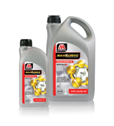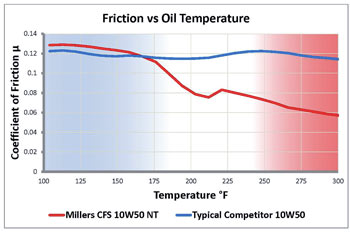About Millers Oils Nanotech

The nanotechnology in Millers Oils' Nanodrive line has been shown to provide significantly better protection to engines, transmissions, and differentials. It does so by reducing friction, which has the side benefits of improving horsepower, reducing operating temperatures, and improving fuel economy. Additionally, a subjective measure of "shift feel" has improved by virtually every customer of ours who has tried the gear oil in their transmission.

Nanotechnology is rooted in a 60 atom sphere called a "Buckey Ball" that looks like a soccer ball at the amotic level. With conventional lubricant, tiny microscopic asperities on the metal's surface slide against each other and break apart. These asperities can be protected by nanoparticles, which act like billions of ball bearings to fill the gaps and make a more uniform surface on the atomic level. The nanoparticles in the Millers Oils are inorganic fullerenes that have multiple layers of nested spheres, and are less than 1/10th of a micron in size (0.000004"). These particles are to a soccer ball as the soccer ball is to the Earth in terms of scale. The nested spheres resemble onion layers, which can exfoliate under extreme pressure and form a protective tribofilm on the metal surfaces. Due to the tremendous surface area, the nanospheres will migrate to and "stick" to the walls of lubricated components.
Millers Oils gear oil with nanotechnology was awarded the Most Innovative New Product at the 2009 World Motorsports Symposium, beating out a data acquisition system from McLaren and the KERS system from Williams. Millers' engine oil was the runner-up for the same award in 2012.
Gear oil:
The current line of gear oils has been in use in many series across Europe such as the British Touring Car Championship, WRC, ASCAR, as well as historic race series. Formula 1 has taken notice, with multiple teams in various stages of testing. After outstanding results with BHA in IndyCar in 2013, some NASCAR teams have begun testing. KAPS and Samsonas now both exclusively specify Millers Oils gear oil with Nano Technology in their dogbox transmissions.
The incorporation of nanotechnology in gear oils provides many benefits, including:
|
 |
|
|
Typical gear oils use molybdenum sulfide (aka "moly") as an extreme pressure lubricant. Millers Oils use of nanotechnology does not break down as readily under pressure. This increase in robustness extends the life of gearboxes, and has proven to nearly double the life of test rigs. It also provides a lower coefficient of friction than does moly. Both behaviors lower gearbox temperatures. Reductions of 20-25OF are typical.
|
Click HERE to view the range of gear oils using nanotechnology.
Engine Oil:
Renowned European engine builder Zytek has tested this new oil in Formula Renault 3.5L Spec V8 engines it supplies for the series, and realized a consistent 5 horsepower improvement over the leading low friction fully synthetic brand. Several other external entities have tested the new Nanodrive oils, with similar to higher improvements.
In addition to the incorporation of nanotechnology, Millers' line engine oils uses tri-ester, PAO, and Group III base stocks with a robust additive package. The benefits of Millers' engine oils include:
 |
|
|
Nontechnology enables Millers Nanodrive engine oils to outperform the competition in two key areas. The first is coefficient of friction. The most damaging friction occurs in boundary conditions, where metal to metal contact exists. The rings at top and bottom dead center are the prominent areas in the engine where this occurs. As previously referenced, nanospheres will stick to the surfaces, better protecting them and reducing friction |
 |
 |
Additionally, nanotechnology in conjunction with an optimized blend of Groups III, IV, and V base stock and additives helps maintain film thickness across the full temperature range. As the film thickness is reduced, more asperities will come in contact with each other, leading to bearing wear, and eventual overhauls. Millers Oils can prolong engine life and reduce overall operating costs through fewer rebuilds. |
The full range of Nanodrive engine oils can be found HERE.
Publications, outside voices, and availability:
Millers Oils has been featured multiple times in many of the better engineering magazines such as SAE International, Racecar Engineering, Race Tech, etc. Millers Oils can be purchased locally at our partner shop, RPR Automotive, located just South of Baltimore, MD in Brooklyn Park.
Waste reduction and better protection:
Having performed engine oil sample testing of many oils, including many leading synthetics, we have learned that viscosity does not always hold up and necessitates a change of oil after one weekend of racing. This becomes expensive in terms of the amount of oil used, and excessive wear and tear. In a sound engine, Millers Oils Nanodrive triple ester oil can run multiple race weekends without changing and without loss of protection. For about $20, we recommend that instead of changing oil take a small sample of oil after every weekend and get a simple analysis done which will tell you how the oil is doing and if it should be changed.
Millers Oils is a small British company on the cutting edge of technology for lubricants for the motorsports industry. Millers maintains a very high percentage of technical employees, and blends all of its products in a single plant in West Yorkshire, UK, ensuring superior and consistent products over larger manufacturers with multiple blending facilities. Millers has remained family owned since its inception nearly 130 years ago, enabling Millers to focus on quality above all other factors.
There are a fair number of racing oils on the market, and even more that are racing oils in branding only . While many companies will tweak their products in response to what is trendy, such as ZDDP content and viscosity index (VI), the best oils start with the best base stocks. More can be read about the base stocks in our FAQ. Millers Oils are designed to give the best results by optimizing the blend ratios such that the different base stocks work to fully complement each other. Additives, including nanotechnology based materials, are then added to give the oil an added level of protection, robustness against acidity.

